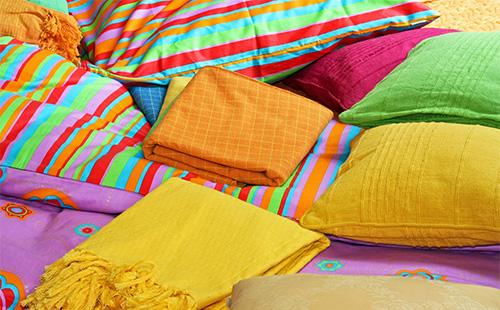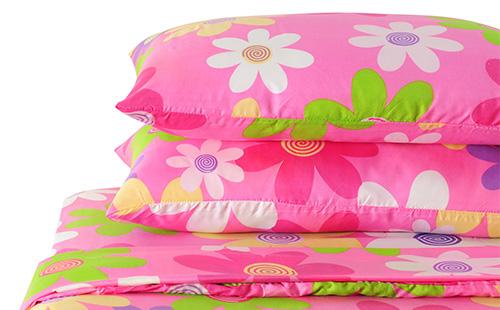The content of the article
You’ll go out like this to a store to buy new bedding and involuntarily think about it ... In the modern textile world, you can simply get lost in ignorance: such a wide selection of bedding is offered by manufacturers. This linen is made of cotton, linen, bamboo, percale, ranfors, dozens of varieties of satin, satin, silk, batiste, polycotton and many other fabrics. So what fabric is better to take bedding from?
Bedding Evaluation Criteria
It is clear that everyone has different tastes, but the quality of the material is the first criterion from which to start your choice of bedding. It doesn’t matter how the material from which your sheets are made is called, it is important how hygroscopic the fabric is, whether it is electrified, rolls or does not roll ... First of all, of course, you need to determine the quality. And then select the size, color scheme and print, determine the manufacturer and price.
the cloth
During sleep, between 80 and 95% of the surface of our skin is in direct contact with bedding. Therefore, items of sleeping bed sets according to hygienic classification are equated with underwear. They have serious sanitary and hygienic requirements. Quality material for bedding:
- “Breathes”;
- absorbs moisture;
- does not cause skin irritation;
- pleasant to the body;
- does not absorb skin fat (otherwise, it fills the gaps between the fibers, and the tissue changes its properties).
Fully natural fabrics meet these stringent requirements. And artificial ones, especially from polyamide, are not hygienic. How to choose the right bed linen, allergists know. And they argue that products made of chemical fibers with prolonged contact can cause chronic allergies and a runny nose, asthma, headaches, and skin diseases.
Density
Nevertheless, many housewives opt for a more expensive but natural canvas. And here's why - unlike synthetic, it is more pleasing to the body and environmentally friendly. The density of the fabric for bedding is an important indicator of quality, affecting its durability and cost. The denser the material, the more washings it will withstand, that is, it will "live" longer. A loose, thinned structure with gaps in the fibers can be determined by eye. Such a “gauze” base is very short-lived and after a short wash cycle just starts to break. Density is indicated on the package and is:
- linear- the number of threads per cm2;
- superficial - tissue weight in grams, measured in g / m2.
Colors
There are no canons in choosing the color of bedding or print. Some people think that linen should fit wallpaper and curtains. Others, listening to the advice of doctors, prefer pastel, calm shades. Still others do not accept the classics and wish to sleep on ultra-bright or “plot” underwear.
Stitches
Solid linen is sewn from a single web, where there are no joints in the middle. The seam is only linen (double stitching), which is visible only on the wrong side. Pay attention to the threads: they must be in tune with the overall color of the kit, and their ends are neatly trimmed and hidden.
Smell
This is what you should also pay attention to when choosing bedding. An unobtrusive aroma of new textiles is permissible. But if you are ready to sneeze from the pungent smell of the dye or the chemical composition of the fabric itself, simply return the bed to its place and continue to study the assortment further.
Dye
The intensity of the color indicates the stability of the dye. It is considered to be of high quality if the color of the front side and the wrong side of the material are approximately the same.
If you are confused by the quality of the dye, try exploring it yourself. Rub the cloth with wet fingers or a damp cloth: if there is a trace, you should refuse such a purchase.
Packaging
There are many factories for sewing home textiles, you won’t remember everything, and this is not necessary. It is important to evaluate: the quality of the packaging, the readability of the information on the labeling, the raw material composition, recommendations for the care of the goods, the production address. By the way, many manufacturers for some reason forget to advise consumers to wash the bedding before first use. But this must be done, and when choosing a bed, the first thing to do is carefully study the packaging.
The size
Bed linens come in many sizes, from nurseries to euros and family.
- Euro. It has the largest sheets and duvet cover.
- Family. Almost like a euro, but with two duvet covers.
- Double. Its maxi variety is the euro. A standard double bed is already shorter by an average of 15-30 cm.
- One and a half. Ideal size for a single bed. It is mainly taken for children and adolescents.
- Children’s. Kits for toddlers (crib).

Fabric for bedding: choose the "right"
A comparative analysis of the most popular materials will help to figure out what bed attributes should be sewn from. Then it will become clear from which fabric it is better to buy bedding.
According to GOST, manufacturers should use only natural fiber for the production of bedding. The leader is cotton; it is present in every house. But in terms of beauty, it is still inferior to silk, and in terms of valuable properties, linen is ahead of all.
Cotton
Cotton has always been the most popular material, leading the ranking of fabrics for the production of bedding. Thanks to modern technologies for weaving and dyeing, cotton varieties were invented based on cotton. As a result, completely different fabrics were obtained from the same raw material.
- Calico Universal, 100% cotton. In its production, a dense thread thickened along the entire length is used. Therefore, the fabric turns out a little rough, durable. Coarse calico does not lose its quality after a large number of washings, even at 60 ° C. Almost does not shed and does not deform; if it dries, it is difficult to smooth out. From cotton fabrics - the cheapest and most practical.
- Chintz. The fragility and fragility of thin calico linen is fully compensated by its cheapness. Pluses: chintz, like all natural fibers, is hypoallergenic, perfectly passes air, does not become electrified, instantly dries. Cons: molt, wears out quickly and, as a result, looks careless and unpresentable. If you intend to purchase cotton underwear, choose a well-known manufacturer.
- Satin Satin linen is made from twisted yarn with double weaving. It looks like glossy and resembles silk. Satin textile is breathable, absorbs moisture well, is highly durable and pleasant to the touch. It tolerates machine wash, almost does not fade and does not crease. The only drawback of this practical material is its high price.
- Batiste. This is a thin, delicate, but very durable fiber. In the old days, linen was used as a raw material for the cambric; modern cambric is made from cotton. Very nice to the body fabric, but does not like frequent washing and its price is quite high (even a cambric shawl has always been considered a luxury).
- Poplin. In the production of poplin, threads of different thicknesses are used (at the base are very thick fibers, transverse threads are thinner by half). Due to this, the texture of the material becomes soft, velvety, with a noble sheen. Poplin bedding - delicate, thin, but durable, ironed without problems. The main condition is washing at a temperature not exceeding 30 ° C. Hot water poplin sits in the water.
- Percale. Material that looks like a cambric in quality is on a par with silk and satin. This is a fabric, in the production of which the threads are not twisted, but rather straightened and, moreover, lubricated with special textile glue. Percale - smooth, delicate, but at the same time quite dense, durable, wear-resistant material: can withstand over a thousand washes.
- Ranfors. This fabric, popular in recent years, is essentially a modernized calico (the threads are thinner and the weave itself is denser). In ranfors, strength and high wear resistance are combined with softness and silkiness. It remains bright for many years: it does not fade, does not sit and is not taken in spools, it is hygroscopic. It is very comfortable for the body and therefore is most often used for the release of children's and teenage bedding.

Bamboo
Bamboo fiber came to us from the east, where it is considered the most environmentally friendly. The fabric is made from raw bamboo pulp. Such linen shines, it is softer than cotton, tactilely resembles silk, absolutely does not absorb odors. A bamboo bedding set is quite expensive, needs careful washing and does not like spinning and drying at high drum speeds.
Silk
Its main features are a very high price and unsurpassed quality. This is a beautiful, dense fabric, excellent in moisture and air. With proper care, silk underwear lasts a long time.
Linen
In the old days, bedding was made only from linen. It was surprisingly cool to the touch and was characterized by high strength and wear resistance. In recent years, textile mills have returned to the production of linen. The fabric is somewhat rough to the touch, but it perfectly lets air through and absorbs moisture, remaining dry. Keep in mind: flax sits after washing, is hard to iron and may fade in the hot sun. Yes, and is not cheap.
Artificial fibers
If you plan to purchase a set of synthetics, try also to determine which material is best for bedding. The main principle: we must look for a fabric with a minimum percentage of chemical fibers. At women's forums, it is advised to pay attention to new generation fabrics, which are sometimes difficult to distinguish from natural ones by eye:
- microsatin;
- rayon;
- pollicotton.
According to reviews, such materials are pleasant for the body, but they do not allow air to pass through well, practically do not absorb moisture, and are electrified. However, they are easily erased, almost do not wrinkle, after washing they do not shrink and do not fade.

Requirements for baby kits
If an adult spends an average of eight out of 24 hours in a bedroom, then a child - at least 12. Consequently, the sanitary requirements for children's sets are more stringent. So which fabric is best for baby bedding? There are two main requirements.
- Natural materials. Because they have high hygienic properties. Coarse calico, satin, ranfors, chintz, flannel are ideal for the baby.
- Neutral color scheme. Children's textiles should be soothing, not disturbing. Bright colors and cheerful colors will suit older children.
Sleep Hygiene Tips
Make it a rule to change bed linen with a regular frequency. According to hygiene standards - every three days in the summer months, in winter - every six to seven days. After a week, the mass of linen increases by at least 10% due to skin secretions, which become a life-giving food for microbes, which is fraught with skin diseases. Consider two more points.
- Do not iron. You will be surprised, but bedding is best not ironed. Especially in summer. As a result of regular ironing, the pores of the tissue become clogged. It loses hygroscopicity (the ability to absorb moisture from the air). The balance is disturbed and the person, while asleep, risks overheating or overcooling.
- Do not starch. In the past, this was a mandatory procedure for every housewife. Starched bedding creaking from cleanliness was a sign of washing quality. Today, this tradition, although it has lost relevance, but still has its fans. So, starch not only prevents the “respiration” of tissue, but also becomes a favorable basis for the propagation of microorganisms.
A few words about leaving
When washing bedding, follow the simple rules, they will help increase its service life:
- wash white items separately from colored items;
- wash fabric of different types separately;
- adhere to the washing mode and temperature specified by the manufacturer;
- select household chemicals appropriate to the type of fabric;
- do not overload the washing machine with laundry - the washing quality will suffer;
- do not accumulate dirty laundry: sweat, particles of the epidermis, sebum change the structure of the tissue;
- pre-treat heavily contaminated areas.
How not to be cheated
According to technologists for sewing sleep accessories, it is impossible for an ordinary buyer to "feel" the quality with their hands. You need either solid work experience or unique intuition.But at home you can use one old "trick". Find a small piece of fabric that is not a pity to cut, and set it on fire. Synthetics will smoke in black. If the material burns like ordinary paper, do not hesitate - it is a natural fabric.
Knowing which bedding is better in quality, the chances that your new bedding set will be real, natural increase many times. The statistics of complaints and negative reviews show that in about 30% of cases we are not sleeping on the material that we were sold to. Be careful and do not let yourself be deceived.

